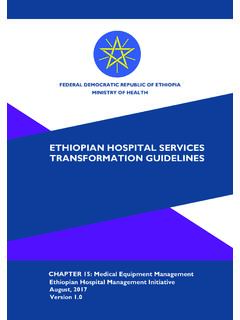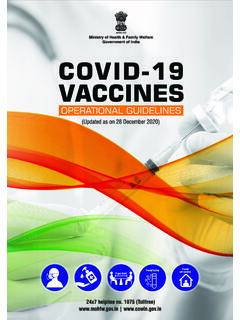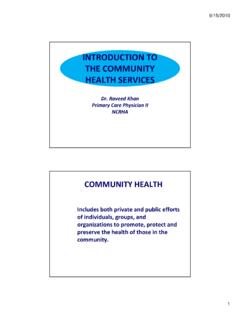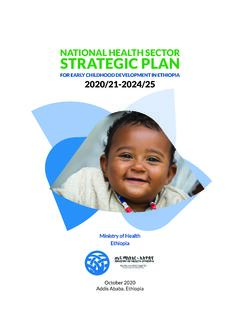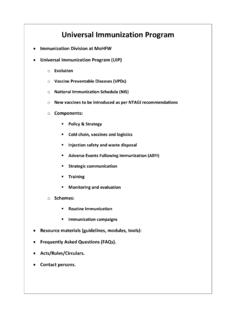Transcription of The Logistics Handbook
1 The Logistics Handbook A Practical Guide for the Supply Chain Management of Health Commodities 2011 This publication was produced for review by the Agency for International Development. It was prepared by the USAID | DELIVER PROJECT, Task Order 1. The Logistics Handbook A Practical Guide for the Supply Chain Management of Health Commodities The authors views expressed in this publication do not necessarily refect the views of the United States Agency for International Development or the United States Government. USAID | DELIVER PROJECT Te USAID | DELIVER PROJECT, Task Order 1, is funded by the Agency for International Development under contract no. GPO-I-01-06-00007-00, beginning September 29, 2006. Task Order 1 is implemented by John Snow, Inc., in collaboration with PATH; Crown Agents Consultancy, Inc.; Abt Associates; Fuel Logistics Group (Pty) Ltd.
2 ; UPS Supply Chain Solutions; Te Manof Group; and 3i Infotech. Te project improves essential health commodity supply chains by strengthening Logistics management information systems, streamlining distribution systems, identifying fnancial resources for procurement and supply chain operation, and enhancing forecasting and procurement planning. Te project encourages policymakers and donors to support Logistics as a critical factor in the overall success of their health care mandates. Recommended Citation USAID | DELIVER PROJECT,Task Order 1. 2011. Te Logistics Handbook : A Practical Guide for the Supply Chain Management of Health Commodities. Arlington, Va.: USAID | DELIVER PROJECT, Task Order 1. Second edition (First edition 1998) Abstract Te Logistics Handbook : A Practical Guide for the Supply Chain Management of Health Commodities ofers practical guidance in managing the supply chain, with an emphasis on health commodities.
3 Tis Handbook will be particularly useful for program managers who design, manage, and assess Logistics systems for health programs. In addition, policymakers, system stakeholders, and anyone working in Logistics will also fnd it helpful as a system overview and overall approach. Key terms and concepts are clearly defned and explained; the document includes detailed information about the design and implementation of Logistics management information systems and inventory control systems. Overviews of quantifcation, procurement processes, as well as storage, transport, and product selection, are also included. Acknowledgments Te USAID | DELIVER PROJECT would like to express its appreciation to the many people who worked on and contributed to Te Logistics Handbook : A Practical Guide for the Supply Chain Management of Health Commodities.
4 Te original Handbook was based on the fagship Logistics course taught by the USAID | DELIVER PROJECT staf (then the Family Planning Logistics Management project staf). In 1992, Barbara Felling and Walter Proper developed the course, and ofered it to logisticians outside the project for the frst time. Te project s Performance Improvement team continued to develop the course, providing many iterations and additional material. In 1998, to increase the number of participants for the course, Barry Chovitz, a trainer and course developer since 1992, developed the Handbook and led the efort to turn the extensive training curriculum into a textbook. Barbara Felling updated the Handbook in 2004 to refect new project knowledge. In 2010, a team of USAID | DELIVER PROJECT technical advisors and staf solicited input from all technical teams to make the most signifcant revision and update to the complete Handbook since it was frst published in 1998.
5 Major contributers included Claudia Allers, Dana Aronovich, Jaya Chimnani, Todd Dickens, Paul Dowling, Barbara Felling, Carolyn Hart, Alexis Heaton, Rich Owens, Leslie Patykewich, Gregory Roche, Eric Takang, and Edward Wilson. Te lead review team included Lilia Gerberg, Kelly Hamblin, Erin Hasselberg, Naomi Printz, and Ashley Smith. Gus Osorio designed the graphics and the layout. Pat Shawkey was the editor. Te stand-alone Handbook is based on a wide range of knowledge and information from staf throughout the project. Cover photo: During the rainy season an ox cart is the only reliable way to get health commodities across the fooded plains to rural health centers in Zambia s western province. (USAID | DELIVER PROJECT 2010). USAID | DELIVER PROJECT John Snow, Inc. 1616 Fort Myer Drive, 11th Floor Arlington, VA 22209 USA Phone: 703-528-7474 Fax: 703-528-7480 Email: Internet.
6 Acronyms vii Preface ix1 . Objectives1 What Is Logistics ? 1 Why Logistics Matters2 Logistics System3 Logistics Cycle: Organizing Logistics System Activities5 Key Logistics Terms9 More Logistics Terms11 Chapter Summary16 2.. Objectives17 Logistics Management Information Systems18 Essential Data for Decisionmaking18 Three Types of Logistics Records 19 Reporting Systems and Summary Reports33 Using an LMIS for Decisionmaking41 Chapter Summary42 3.. Assessing Stock Status43 How to Assess Stock Status44 When to Assess Stock Status46 Stock Status Assessment at Any Level in the System46 Chapter Summary53 4.. Objectives55 Purpose of an Inventory Control System55 Key Inventory Control Terms56 Three Types of Max-Min Inventory Control Systems57 Determining How Much to Order or Issue57 Determining When to Place an Order or Issue58 Setting Max-Min Levels64 Two Design Issues for Inventory Control Systems 69 Selecting an Appropriate Max-Min System71 Chapter Summary 75 5.
7 Purpose of Product National Essential Medicines List Registration of Pharmaceutical Standard Treatment Donor Laboratory Supplies and Equipment Standardization81 Chapter ..iv THE Logistics Handbook A PRACTICAL GUIDE fOR THE SUPPLy CHAIN MANAGEMENT Of HEALTH COMMODITIES 6.. Objectives85 Importance of Quantifcation 86 Key Steps in Quantifcation86 Using the Quantifcation Results95 Reviewing and Updating the Quantifcation96 Chapter 7.. Objectives99 Why Procurement in the Supply Chain Is Important99 Procurement Process 101 Key Challenges faced in Procurement108 Chapter 8.. Objectives113 Storage114 Visual Inspection118 Storage Space Requirements 120 Physical Inventory Count 122 Health Care Waste Distribution124 Chapter Summary 126 9.. Objectives129 Monitoring and Evaluation basics129 Developing an M&E Plan132 Indicators for M&E of Supply Chains135 Data Collection Methodologies137 Data Collection Tools139 Providing feedback and Reporting Results141 Chapter Summary 142 10.
8 Objectives143 Logistics System Design Process143 System Design Elements148 Other Design Considerations152 Chapter Summary156 References159 Figures figure 1-1: Correlation between Contraceptive Prevalence Rate and Product Availability 3 figure 1-2: The Logistics Cycle5 figure 1-3: Typical Public Sector In-Country Supply Pipeline 10 figure 2-1: The Logistics Cycle17 figure 2-2: bin Card21 figure 2-3: Inventory Control Card22 figure 2-4: Stores Ledger (cover, table of contents, product page)23 figure 2-5: Issue and Receipt Voucher25 figure 2-6: Issue and Receipt Voucher flow26 v ..figure 2-7: Requisition, Issue, and Receipt Voucher27 figure 2-8: Requisition, Issue and Receipt Voucher flow28 figure 2-9: Daily Activity Register 30 figure 2-10: Daily Usage Log31 figure 2-11: Tick Sheet32 figure 2-12: Sample Logistics Reporting System: National Vaccine Program 34 figure 2-13: Monthly Report and Request for ARVs (last page of a four-page form)37 figure 2-14: feedback figure 2-15: Decisionmaking Process 41 figure 3-1: Stock Status Assessment 49 figure 4-1: fuel Gauge56 figure 4-2: Lead Times64 figure 5-1: The Logistics Cycle77 figure 6-1: The Logistics Cycle85 figure 6-2: Steps in Quantifcation.
9 86 figure 7-1: The Logistics Cycle99 figure 8-1: The Logistics Cycle113 figure 8-2: Sharps box123 figure 9-1: Program Cycle for Supply Chain Systems figure 9-2: Relationship between Goals, Objectives, Interventions, and Indicators 135 figure 10-1: Logistics System Design Process143 Tables Table 1-1: Advantages and Disadvantages of Allocation and Requisition Systems12 Table 2-1: Three Essential Logistics Data Items19 Table 4-1: Sample Max-Min Levels69 Table 4-2: factors for Selecting a Max-Min Inventory Control System73 Table 6-1: Preparation Process 87 Table 6-2: forecasting Process88 Table 6-3: Types and Sources of Data for forecasting Product Consumption89 Table 6-4: Data Quality Analysis for ARV Drug Quantifcation in Tanzania90 Table 6-5: Conversion of Data into Product Quantities91 Table 6-6: Supply Planning Process93 Table 6-7: Supply Planning Data Requirements93 Table 7-1: The Product Supply Process (PATH 2009)102 Table 8-1: Storage Guidelines116 Table 8-2: Common Product Quality Problems119 Table 8-3.
10 How to Calculate floor Space121 Table 9-1: Objectives and Interventions Worksheet133 Table 9-2: M&E Workplan Worksheet134 Table 10-1: Summary of Implications of System Design Decisions155 vi THE Logistics Handbook A PRACTICAL GUIDE fOR THE SUPPLy CHAIN MANAGEMENT Of HEALTH COMMODITIES AcronymsABC abstinence, be faithful, use condoms AIDS acquired immune defciency syndrome ALu artemether+lumefantrine (antimalarial medicine) AMC average monthly consumption ARI acute respiratory infection ART antiretroviral therapy ARV antiretroviral ATLAS Assessment Tool for Laboratory Service CBD community-based distributor or distribution CMS Central Medical Stores CPR contraceptive prevalence rate CSCMP Council of Supply Chain Management Professionals CYP couple-years of protection DAR daily activity register DHS Demographic and Health Survey DTTU delivery truck topping-up (inventory control system)


